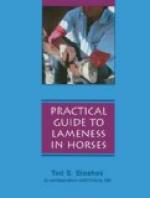Wounds From Interfering.
When, during locomotion, injury is inflicted upon the mesial side of an extremity by the swinging foot of the other member, the condition is termed interfering.
Etiology and Occurrence.—Faulty conformation, bad shoeing and over-work are the principal causes of interfering. Horses that are “base narrow” or that have crooked legs are quite apt to interfere. Shoes that are put on a foot that is not level or applied in a twisted position, or shoes wide at the heel will often cause interfering and injury. Animals that are driven at fast work until they become nearly exhausted may be expected to interfere. Such cases are frequently observed in young horses that are driven over rough roads, particularly when so nearly exhausted or weakened from disease or inanition that the feet are dragged forward rather than picked up and advanced in the normal manner.
Symptomatology.—Wounds inflicted by striking the extremities in this manner present various appearances and occasion dissimilar manifestations. The hind legs are almost as frequently affected as the front and the fetlock region is most often injured, though wounds may be inflicted to the coronet. In front, the carpus is sometimes the site of injury.
When only an abrasion is caused, little if any lameness occurs, but where interfering is continued and nerves are involved or subfascial infection and extensive inflammation succeed such abrasions, marked lameness and evidence of great pain are manifested. Frequently, in chronic cases affecting the hind leg, the fetlock assumes large proportions, and at times during the course of every drive the subject strikes the inflamed part, immediately flexing and abducting the injured member, and the victim hops on the other leg until pain has somewhat subsided.
Interfering is much more serious in animals that are used at fast work than in draft horses. In light-harness or saddle horses, it may render the subject practically valueless or unserviceable if the condition cannot be corrected.
Treatment.—Wherever possible, cause is to be removed and if animals are properly used, ordinary interfering wounds will yield to treatment. If the shoeing is faulty, this should be corrected, the foot properly prepared and leveled before being shod and suitable shoes applied. In young animals that become “leg-weary” from constant overwork, rest and recuperation are necessary to enhance recovery. In such cases it will be found that very light shoes, frequently reset, will tend to prevent injury to the fetlock region such as characterizes these injuries of hind legs.
Palliative measures of various kinds are employed where cause is not to be removed and a degree of success attends such effort. In draft horses or animals that are used at a slow pace, shields of various kinds are strapped to the extremity and protection is thus afforded. Or, large encircling pads of leather, variously constructed, serve to cause the subject to walk with the extremities apart.




